He left his grandmother
I wanted to wait for NASA's official report on Curiosity activities, but it seems that people are completely bored with it, since someone already sees flowers on the Martian prairies. And NASA delays the story of new achievements, so let's start without them. Yes, Curiosity has findings, and even such that can be confounded by experienced explorers of Mars, not to mention enthusiasts.

NASA doesn’t know what “abruptly” is, therefore, regardless of the cost of working time of the rover, the Jet Propulsion Laboratory almost went off to the Christmas holidays. Before that, the operators drove the Curiosity into a place from which to observe the surrounding slopes well. They called Grandma's House, the grandmother's house, where they think it is best to celebrate Christmas. In order for Curiosity not to mess around, he was prepared a multi-day program of work. Usually he is given a program for the day, but this time he has planned activities for the week ahead. This technique is useful in April, when the Sun will be between Mars and the Earth and the connection will be interrupted for several days.
During the holidays, the rover took a full 360-degree panorama of the left 34-mm mast camera, and took a large panorama of the nearby outcrops of the right 100-mm mast camera.
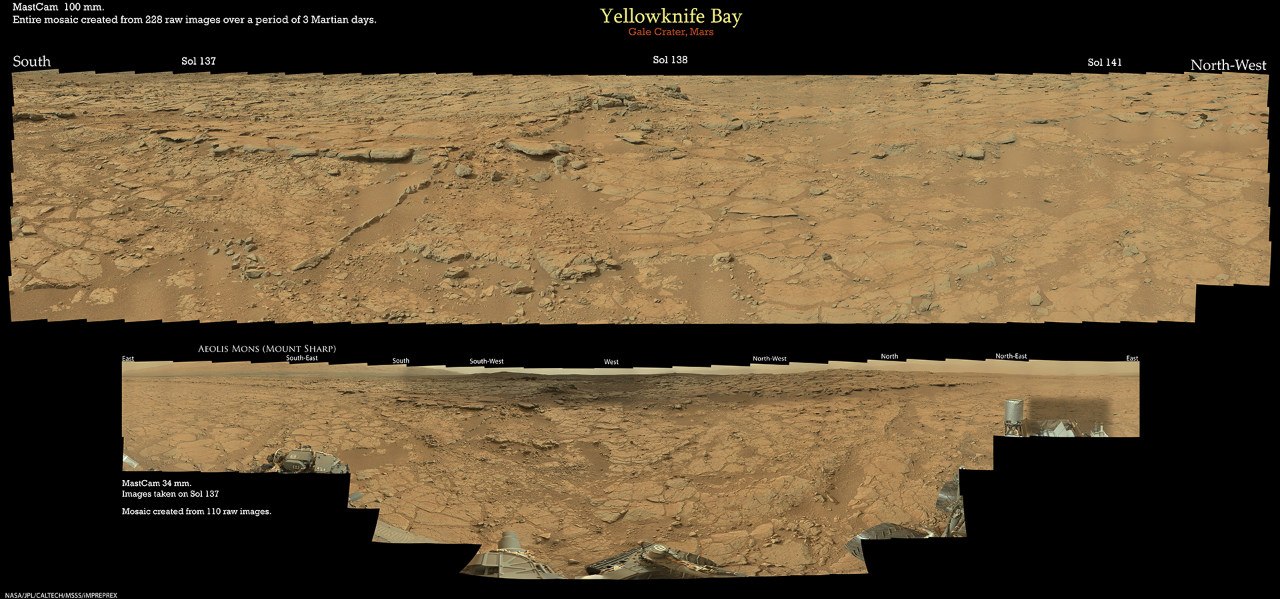
Full size in gigapan
')
It was important not only to take photos, but also to send them, because weak communication leads to the fact that the rover stores some frames received a month ago, or even more. During the holidays, we managed to transfer all the new pictures and place them on the bottom of the barrel.
For example, this “Hazy Mountain” has practically no scientific value, so for more than a month there were more important things that need to be sent.

This is a shot of 100 sol (Martian day), when a dust storm approached the Curiosity from the south. A few days later it became clear, but all the same now - on the 148th Sol - the appearance did not return to the previous one.
Panoramas opened a lot of sites that may cause interest not only boring geologists, but also the surprise of outsiders.
However, interesting began even earlier. I have already said that in the lowlands of Yellowknife Bay, the rover discovered a new white mineral that filled cracks in the underlying, dark rock.

( false color )
At the same time, the rover examined and the stone, which then journalists will call "the Martian flower."
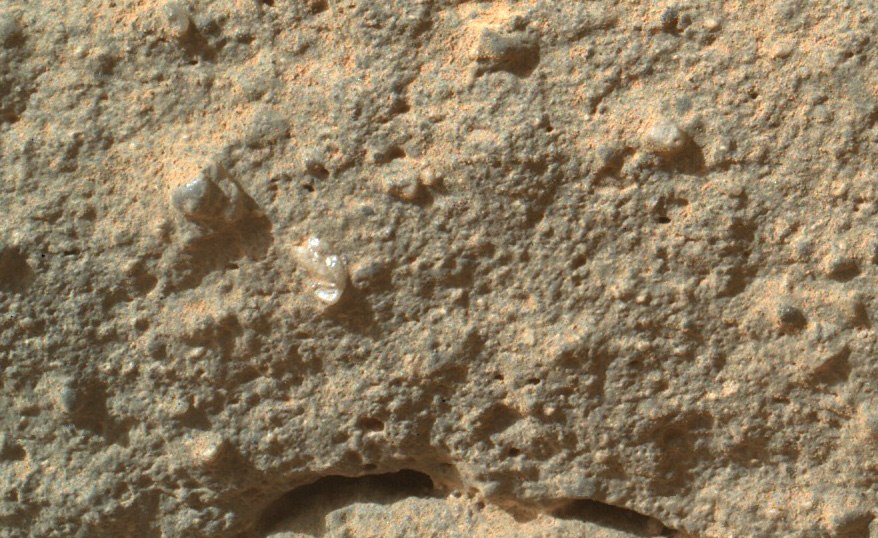
It is most likely quartz or some kindred silicon compound that has no sensation. And how it got into the headlines, I will tell later.
After the rover examined the "flower", he moved to his grandmother's house for the holidays. It was then that the discovery was made, from which I, for a minute, had my eyes on my forehead.
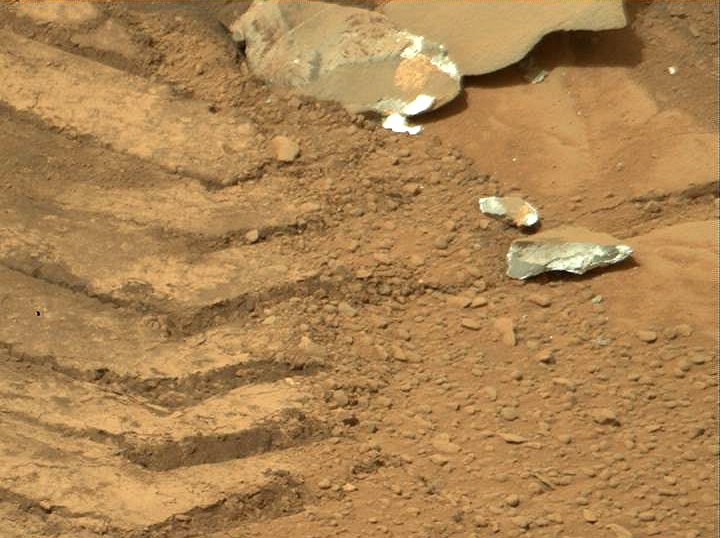
It is somehow hard to believe that in this kingdom of red stones and brown sands it can survive, something so piercingly white. There is also not clear whether this stone is so fragile, or whether it is a rover so heavy. The fact that he is really heavy can be guessed from this amazing frame:
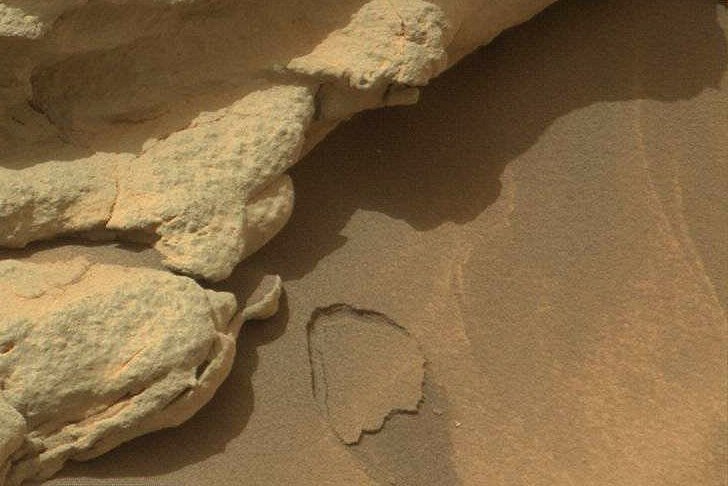
The Curiosity movement caused such an amusing micro-landslide a couple of meters from the robot. But, apparently, these stones are fragile. In one picture, you can trace all the way through the new white cracks.
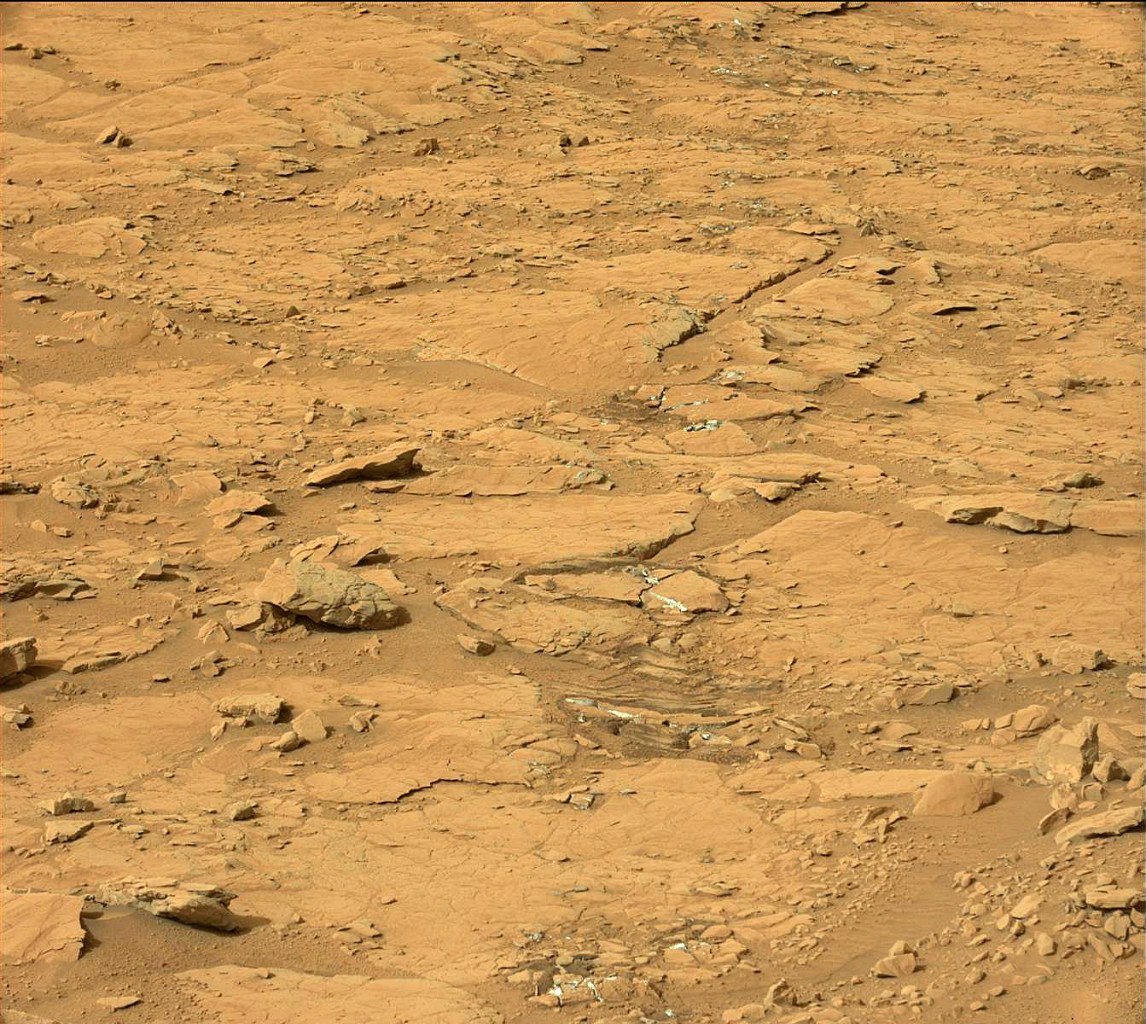
What kind of NASA mineral has not yet been told, however, low interest in these findings from the rover suggests that there will be no sensation.
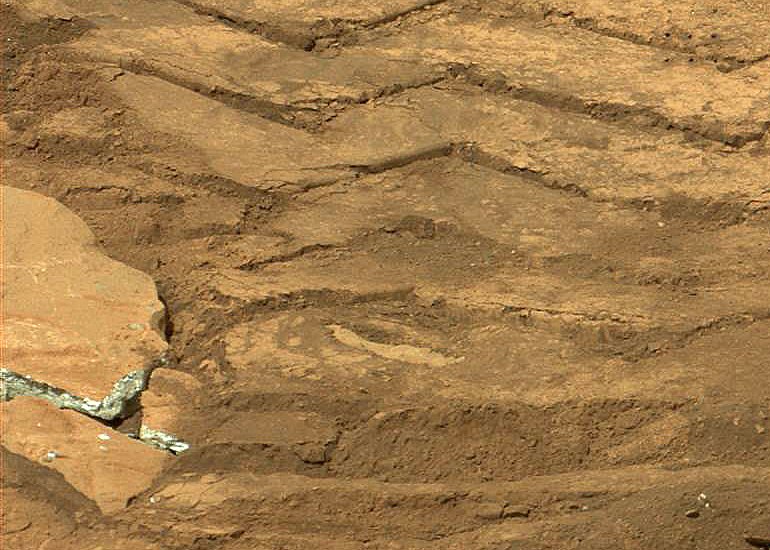
They shot a little laser at him, but did not even consider using the camera on the manipulator. Although the stones do not run away from them and are still at hand, they can also be engaged.
But Grandma's House found a more interesting object.

Sizes larger
The unusual ridge of stones, visible on the right side of the panorama, is called the Snake River. I have long been interested in it, as soon as it appeared on the frames of navigation cameras. The stones lined up in a strange line clearly under the influence of some processes. Two options can be assumed immediately - this is a moraine or a crack filling.
Moraine is a chain of stones, which, like a bulldozer, collects a glacier during movement. The moraines themselves are not new to Mars.
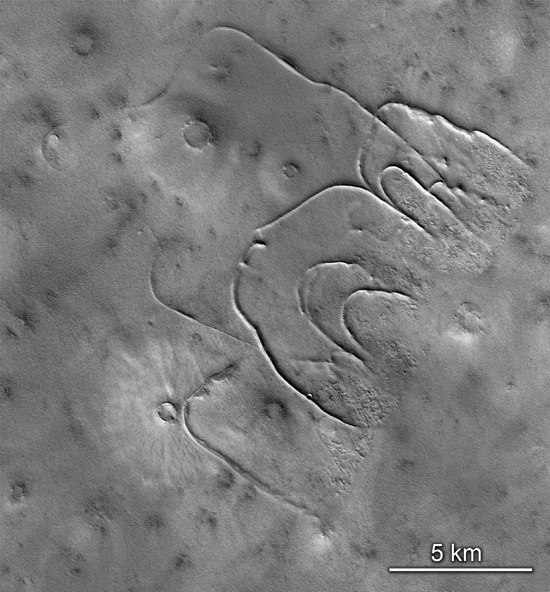
But in the crater of Gale, no direct evidence of glacier activity has been found either in kilometer or meter scale.
The second possibility of the appearance of such a linear structure is the filling of a crack. That is, there was some kind of rock (although maybe ice) that cracked, these stones attacked into the crack. Then the whole base was destroyed (melted, weathered, was washed away), and the stones that fell into the crack, turned out to be stronger and remained in place. The strangeness here is that such processes should cover all the surroundings, while the “snake” has so far found only one.
What will decide about this NASA, we will soon find out. The research process has just begun.
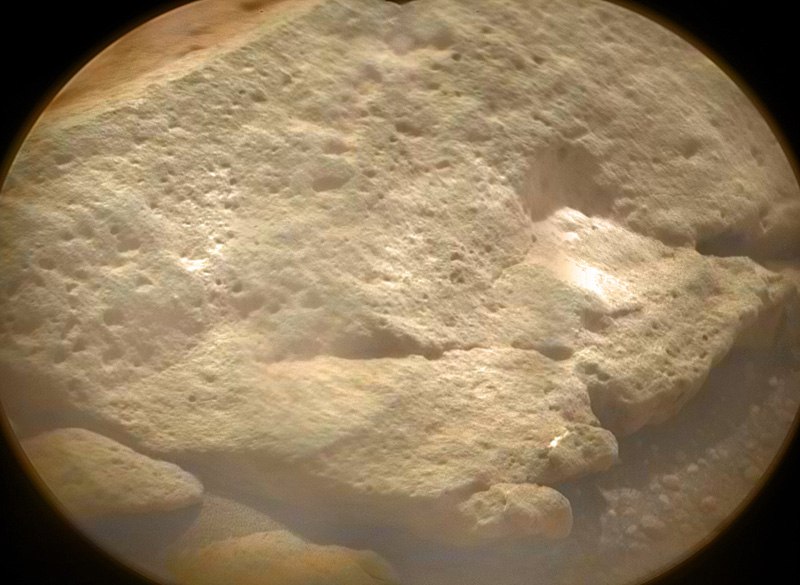
There is there and without Snake River what to see and how to tickle the imagination. For example, if I had found such a stone in a career near Moscow, I would not doubt for a second that it was a fossil.
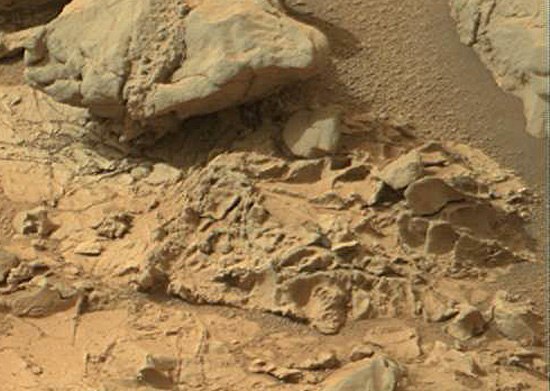
And when you see these “twigs”, it is more appropriate to talk about flowers and other green plantings.
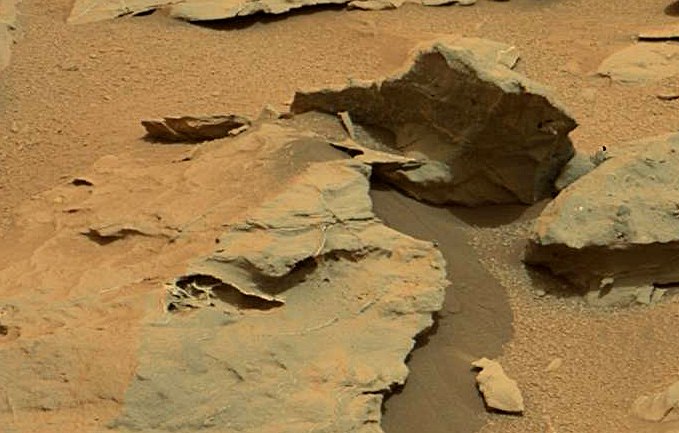
But here, everything is much simpler: cracked rock => filling of cracks with white mineral => weathering of the main rock and stronger ties of white.
The white mineral in the cracks is most likely gypsum. They have not yet told about him, but there is every reason to assume that he is the one. But the bright white contents of fragile stones may turn out to be different. Recalling the activities of the "neighbor" Curiosity - Spirit, whose anniversary was recently celebrated, you can compare its find:
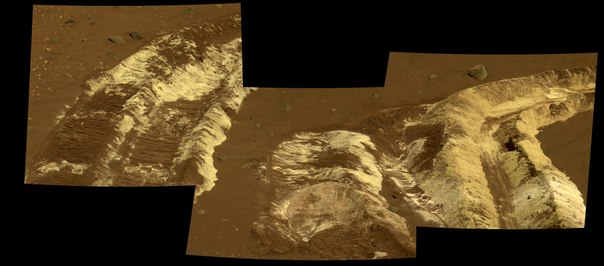
In his case, it turned out to be placers of sulphate salts. In another place, a similar find turned out to be quartz sand - an ideal raw material for glass production. In the crater of Gusev, where the Spirit worked, these placers arose during hydrothermal activity, but geysers were not supposed to be in the Gale crater. The situation will be cleared up a bit when spectrographic analyzes are known, so it only remains to wait and not read Soviet newspapers at dinner.
Now, regarding the “Martian flower” and the newsmen. His example shows how our avid sensational media works.
Since December 3, when the previous epic “ what did he find there ” ended , NASA did not tell scientific news from Gale's crater. Media editors understand that people crave for Mars, but there is no news from Mars. Then the most intelligent journalist goes to the ufological forum chooses the most absurd comment “Flower?”, And writes “the discovery stirred up the discussion forum” (despite the fact that at the forum itself, most acknowledged that this is an ordinary quartz-type stone). Further, the editor writes a little ad-libbing “possibly a bright object fell off the rover,” adds a specialist comment: “This is a piece of rock” and it's done. The article is published, and then it is started to be reprinted and translated by other media: the links to the ufological forum are removed, the comments of the specialist and only the " Mars rover photographed the flower on Mars " remains.

NASA doesn’t know what “abruptly” is, therefore, regardless of the cost of working time of the rover, the Jet Propulsion Laboratory almost went off to the Christmas holidays. Before that, the operators drove the Curiosity into a place from which to observe the surrounding slopes well. They called Grandma's House, the grandmother's house, where they think it is best to celebrate Christmas. In order for Curiosity not to mess around, he was prepared a multi-day program of work. Usually he is given a program for the day, but this time he has planned activities for the week ahead. This technique is useful in April, when the Sun will be between Mars and the Earth and the connection will be interrupted for several days.
During the holidays, the rover took a full 360-degree panorama of the left 34-mm mast camera, and took a large panorama of the nearby outcrops of the right 100-mm mast camera.

Full size in gigapan
')
It was important not only to take photos, but also to send them, because weak communication leads to the fact that the rover stores some frames received a month ago, or even more. During the holidays, we managed to transfer all the new pictures and place them on the bottom of the barrel.
For example, this “Hazy Mountain” has practically no scientific value, so for more than a month there were more important things that need to be sent.

This is a shot of 100 sol (Martian day), when a dust storm approached the Curiosity from the south. A few days later it became clear, but all the same now - on the 148th Sol - the appearance did not return to the previous one.
Panoramas opened a lot of sites that may cause interest not only boring geologists, but also the surprise of outsiders.
However, interesting began even earlier. I have already said that in the lowlands of Yellowknife Bay, the rover discovered a new white mineral that filled cracks in the underlying, dark rock.

( false color )
At the same time, the rover examined and the stone, which then journalists will call "the Martian flower."

It is most likely quartz or some kindred silicon compound that has no sensation. And how it got into the headlines, I will tell later.
After the rover examined the "flower", he moved to his grandmother's house for the holidays. It was then that the discovery was made, from which I, for a minute, had my eyes on my forehead.

It is somehow hard to believe that in this kingdom of red stones and brown sands it can survive, something so piercingly white. There is also not clear whether this stone is so fragile, or whether it is a rover so heavy. The fact that he is really heavy can be guessed from this amazing frame:

The Curiosity movement caused such an amusing micro-landslide a couple of meters from the robot. But, apparently, these stones are fragile. In one picture, you can trace all the way through the new white cracks.

What kind of NASA mineral has not yet been told, however, low interest in these findings from the rover suggests that there will be no sensation.

They shot a little laser at him, but did not even consider using the camera on the manipulator. Although the stones do not run away from them and are still at hand, they can also be engaged.
But Grandma's House found a more interesting object.

Sizes larger
The unusual ridge of stones, visible on the right side of the panorama, is called the Snake River. I have long been interested in it, as soon as it appeared on the frames of navigation cameras. The stones lined up in a strange line clearly under the influence of some processes. Two options can be assumed immediately - this is a moraine or a crack filling.
Moraine is a chain of stones, which, like a bulldozer, collects a glacier during movement. The moraines themselves are not new to Mars.

But in the crater of Gale, no direct evidence of glacier activity has been found either in kilometer or meter scale.
The second possibility of the appearance of such a linear structure is the filling of a crack. That is, there was some kind of rock (although maybe ice) that cracked, these stones attacked into the crack. Then the whole base was destroyed (melted, weathered, was washed away), and the stones that fell into the crack, turned out to be stronger and remained in place. The strangeness here is that such processes should cover all the surroundings, while the “snake” has so far found only one.
What will decide about this NASA, we will soon find out. The research process has just begun.

There is there and without Snake River what to see and how to tickle the imagination. For example, if I had found such a stone in a career near Moscow, I would not doubt for a second that it was a fossil.

And when you see these “twigs”, it is more appropriate to talk about flowers and other green plantings.

But here, everything is much simpler: cracked rock => filling of cracks with white mineral => weathering of the main rock and stronger ties of white.
The white mineral in the cracks is most likely gypsum. They have not yet told about him, but there is every reason to assume that he is the one. But the bright white contents of fragile stones may turn out to be different. Recalling the activities of the "neighbor" Curiosity - Spirit, whose anniversary was recently celebrated, you can compare its find:

In his case, it turned out to be placers of sulphate salts. In another place, a similar find turned out to be quartz sand - an ideal raw material for glass production. In the crater of Gusev, where the Spirit worked, these placers arose during hydrothermal activity, but geysers were not supposed to be in the Gale crater. The situation will be cleared up a bit when spectrographic analyzes are known, so it only remains to wait and not read Soviet newspapers at dinner.
Now, regarding the “Martian flower” and the newsmen. His example shows how our avid sensational media works.
Since December 3, when the previous epic “ what did he find there ” ended , NASA did not tell scientific news from Gale's crater. Media editors understand that people crave for Mars, but there is no news from Mars. Then the most intelligent journalist goes to the ufological forum chooses the most absurd comment “Flower?”, And writes “the discovery stirred up the discussion forum” (despite the fact that at the forum itself, most acknowledged that this is an ordinary quartz-type stone). Further, the editor writes a little ad-libbing “possibly a bright object fell off the rover,” adds a specialist comment: “This is a piece of rock” and it's done. The article is published, and then it is started to be reprinted and translated by other media: the links to the ufological forum are removed, the comments of the specialist and only the " Mars rover photographed the flower on Mars " remains.
Source: https://habr.com/ru/post/164759/
All Articles